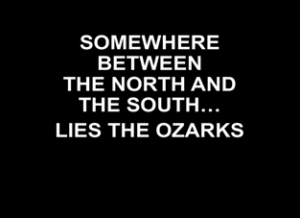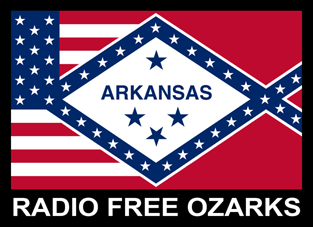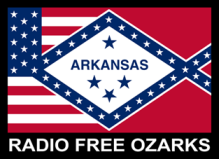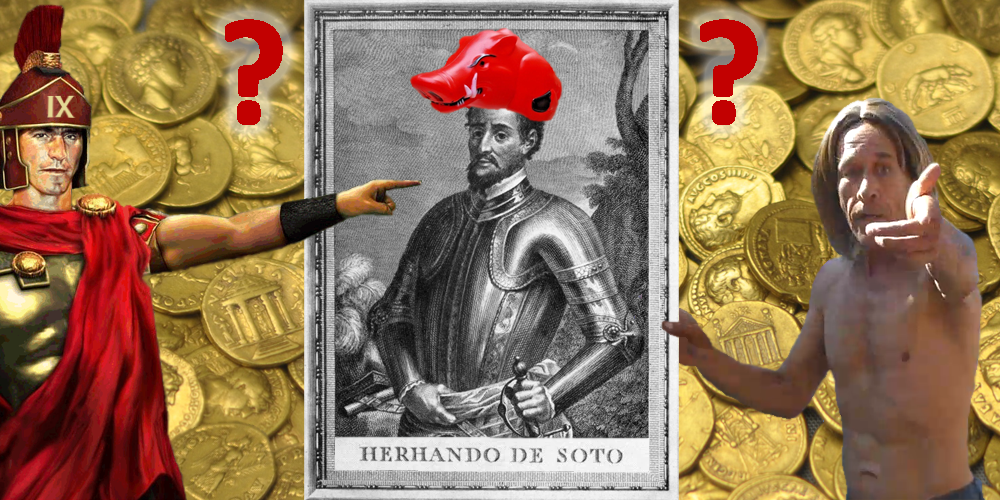EXCLUSIVE: WAS HERNANDO DE SOTO ON THE TRAIL OF LOST ROMAN GOLD IN HOT SPRINGS?
BEAUCOUP STASH OF ANCIENT GOLD COINS POSSIBLY WAITING TO BE FOUND INSIDE HOT SPRINGS MOUNTAIN
By Dr. Fred Potato
Radio Free Ozarks Editor
October 21st, 2023
Two rebellious archaeologists, exploring a newly-uncovered grotto tucked inside of Hot Springs Mountain, made startling one-two punch discoveries this past April. An ancient Roman gold coin was found in a shallow pool inside the stiflingly hot cave. The find, along with an ancient fragment of pottery unearthed nearby, tantalizingly gives hopes of solving one of the great mysteries of antiquity, and of finding a friggin motherlode of gold coins hidden deeper inside the mountain cave.
The coin was analyzed and confirmed to be an authentic Roman aureus, a gold coin regularly issued by Rome from the 1st century BC to the beginning of the 4th century AD. The aureus found bears the likeness of the Roman Emperor Hadrian, who reigned from AD 117 to AD 138. The date of minting for these coins lines up astonishingly well with the disappearance of the fabled Roman Ninth Legion, which vanished from northern Britain at some point in the decades following AD 120 and was never heard from again.
But it is the pottery shard found in a Caddo tribe trash pit that makes an astonishing strong case that it was the Ninth Legion that ended up in what is now Arkansas. The Roman Ninth Legion’s appearance, if confirmed, would mean that Europeans first visited the state more than 1300 years before the 1539-1543 expedition of Spanish explorer and conquistador Hernando de Soto. This Roman excursion into the New World would even best the Vikings’ short-lived colony in Greenland by more than 800 years.
But hey, let’s not get ahead of (or behind) ourselves.
Radio Free Ozarks spoke with the two archaeologists who made the find, Dr. Theo Jankus and Dr. Francis Pope from the Arkansas Archaeological Posse. The AAP is a loose collective that is part of the so-called “Alternative Archaeology” movement that everyone is talking about.
Dr. Pope, 51, lanky and balding, is an alumnus and former Assistant Professor of Native American Studies at Ouachita Baptist University. He mostly let Dr. Jankus to the talking during our interview, his eyes hidden behind the shaded lenses of his spectacles. Dr. Jankus merely smiled when asked his age. A lean and sinewy [Editor’s Note: our $9 word for today] man, with long, unwashed grey hair and pale, leathery skin, Dr. Jankus apparently earned his PhD. at the University of the West Indies, in Mona, Jamaica.
[Editor’s Note: The following interview has been edited for length and clarity, and to remove some drug use references.]
Our interview started outside Dr. Pope’s brother-in-law’s garage in Little Rock. Parked outside was a 1983 Dodge van that had clearly seen better days. The sides of the green van had “ARKANSAS ARCHEOLOGICAL POSSE” misspelled on them, the product of what appeared to be black spray paint used over some store-bought stencil letters.
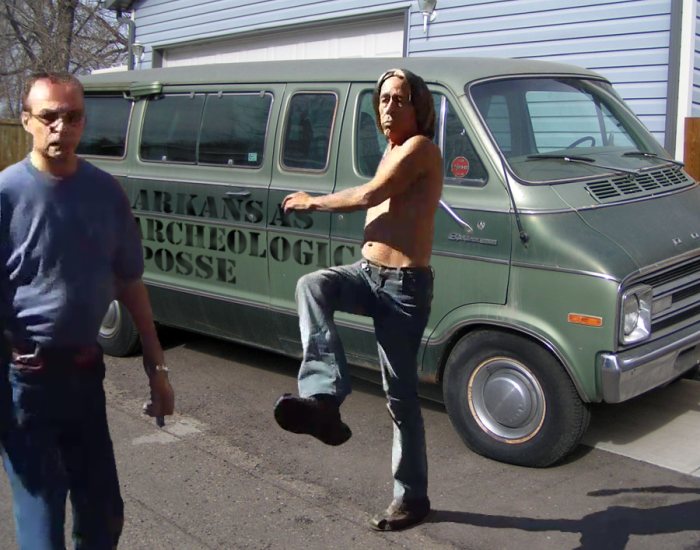
The AAP is an unofficial offshoot of the much larger Arkansas Archaeological Society. “We don’t talk about [the AAS], Dr. Jankus noted, while shirtless and drinking from a jug containing a mixture of orange juice and vodka. “There were some disagreements on how the society was run. Some disagreements on the digs. Too much mud slinging.”
“Literal mud slinging,” added Dr. Pope in a very slow southern drawl, as he spat into his chaw cup, a 7-Eleven cup he had found on the ground minutes earlier.
Dr. Jankus: “I was told that I wasn’t Archaeological Society material. I was told to leave. Excommunicated. I wear it as a badge of honor. Mostly Frank and I are the Posse. He came with me. Gave up his tenure track at OBU. Our friends sometimes help, but they all go away in the end. We like to live our life at a faster pace.
Dr. Pope: “They hate us because of our iconoclastic swagger.”
Dr. Jankus: “This all started a year ago, at the annual Archaeological Field Day. The Field Day was digging at a possible site of the Caddo village of Chaguate. This was in Garland County, but obviously the Caddo people wouldn’t have known that. That would be stupid.
“From the start of the dig, Frank and me were treated like outcasts. I wanted to crank up the Sex Pistols, but that main group just wanted to listen to NPR. So Frank and me were given a crap assignment, digging in this sunken pit, between a couple of rock outcroppings. Far away from the main group and their All Things Considered.
“Digging down a few feet took several hours, but then we started to find some artifacts. Tools made from bone. Broken arrow points. Bones with axe marks. Pottery shards, consistent with other Caddo finds. This was indeed some sort of Native American trash pit, from a time long before Columbus.
“It was getting late. The main group had packed it up and gone to Chick-fil-A. They didn’t bother to tell us. But Frank and me were on to something, reaching back hundreds or thousands of years. We were there past midnight, working by the light of my Coleman lantern. At nearly 1 a.m., we came across it. A larger pottery shard, which might look like any other that I’ve dug up. But this one was a different material, and it had an inscription fired into it. It made us weak in the knees. The inscription, in Latin letters, was of the Roman Ninth Legion. I [expletive] you not. And someone had scratched out a likeness of a Roman Centurion next to it.”
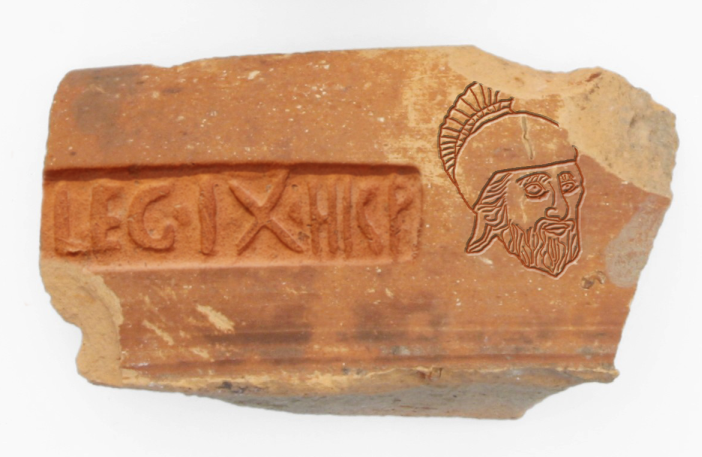
Dr. Jankus explained that he and Dr. Pope carefully cleaned and stored the fragment, then had it discreetly dated by friends in physics department at Arkansas Tech. The (non-peer-reviewed) results, using thermo-luminescence dating: the pottery fragment was fired in approximately AD 130. The fragment is now stored at Dr. Pope’s brother-in-law’s garage, where our interview continued. The fragment awaits further testing, and possible sale.
In the garage, Dr. Pope sat down at a card table. “The Native Americans, the Caddo people. They didn’t have a written language to send their memories down the line to us. But there was a strong tradition of oral histories, mythology, passed down from generation to generation. Did we ever stop long enough to listen? We kept our little discovery to ourselves and decided to do some research. We knew exactly where to go. And I don’t mean the library.”
Dr. Jankus: “Frank and me, we gassed up the van and traveled the winding highways and byways to central Oklahoma. Caddo County. For some ‘alternative research,’ you might say. Hit the small Caddo Nation casino outside of Binger. Drank and gambled our way into some good graces. Out in the back, our Caddo friends let us in to a secret Ayahuasca ceremony. They said the ceremony was a sacred tribal ritual, dating all the way back to 2009.”
Dr. Jankus described ingesting the nasty hallucinogenic brew, made from rare plant vines and used in numerous tribal rituals in South America.
Dr. Jankus: “It was sickening, [and] intense, yet peaceful. I thought I was going to black out, but then I had a vision. An intense and very real vision of walking along the Ouachita River, in a time long ago, into the Caddo village of Chaguate. Our very same trash pit was nearby. I was greeted there, as a friend, by the spirit of a wise Caddo elder. We sat under a sky that was so dark, yet also so glowing and alive from the incredible number of stars. He said his name was Black Oak. I could understand him perfectly.
“We sat for a moment, then I told him of my journey. He seemed amused by my tale and by how I looked, but then he told me about two major events in his tribe’s history. Their first two encounters with the white man (his words, not mine). And both had happened at The Valley of the Vapors, which we now know as Hot Springs, along Bathhouse Row.
“The first time was when the Caddo tribe was visiting the springs. The event happened long before Black Oak’s time, but the tale was handed down, over many generations, through his tribe’s strong tradition of oral history. That tale, Black Oak told me, was what they called ‘The Visit of Men with Funny Hats and Beards’. It was a tradition to for his tribe to visit the springs after the hard work of the fall harvest was done. Competing tribes from all around would lay down their weapons in a truce, and bathe in the revered springs. To share in their warm, healing properties. And get off with each other.
“But one year an otherworldly group of soldiers wandered in to tribal gathering, lost and confused. Several hundred of them, perhaps. The tale, told over the many years, always made note of the soldiers’ red outfits and magical armor and odd hats. It was clear to me that Black Oak was describing Roman centurions! The soldiers spoke a strange language and could not be understood, but it was clear they were far from home, weary and very lost. They didn’t even bathe in the springs! They threatened the tribes at the springs and forced them to leave the area.
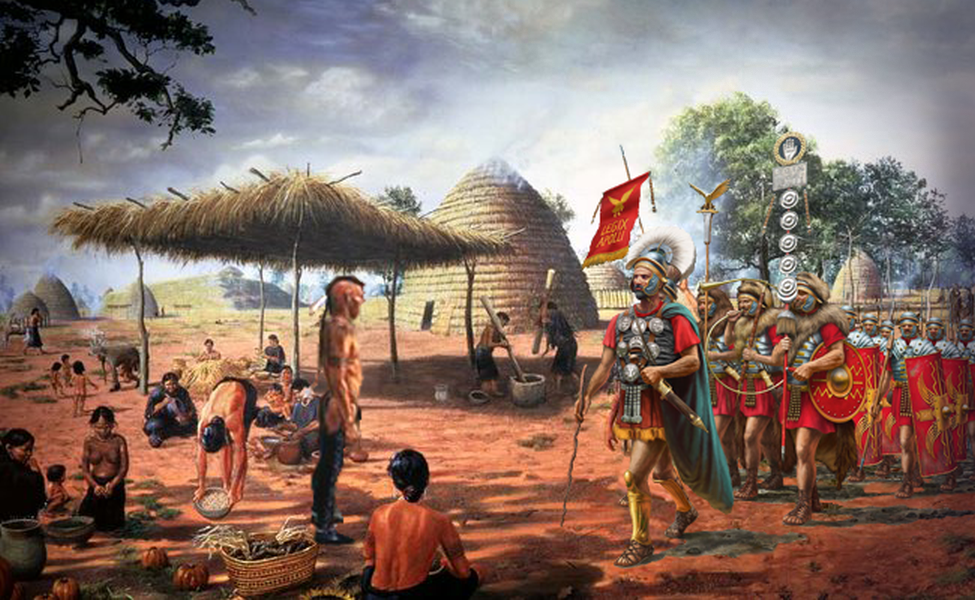
“That evening, one of the mightiest Caddo warriors, who had stayed behind and hidden in the woods, spied on the soldiers. They had retreated further up the hill, at a cave opening where one of the streams of hot water flowed out of the hillside. There seemed to be some disagreement between their leaders. An argument. Like they were at the end of their rope. Then a decision was made, and some of the soldiers could be seen moving several large wooden boxes into the cave.
“The men would later stagger out, vomiting, nearly overcome by the heat. And then they worked to hide the mouth of the cave, using large rocks and soil. And come the next morning they were all gone. The only traces they left behind were their boot prints. And some oblong pottery, which the Caddo warrior took with him. I realized that Black Oak was describing the Roman amphorae, and that the fragment we found was from one of these.
“Black Oak’s tribe made plans to quickly return to the Hot Springs to see what had been buried in the hillside. But a terrible sickness quickly spread through all the tribes in the area, killing half of the population over the course of the coming winter. The Roman centurions had brought sickness and despair with them. Several more cycles of the seasons would pass before the Caddo tribe would return to the springs, but no one wanted to disturb what lay buried, out of fear that more sickness and misery would be unleashed on the world.
“Black Oak then told me that, as a young Caddo warrior, he was witness to his tribe’s second encounter with the white man (again, his words…not mine). Once again the Caddo were visiting the springs, taking in their warm healing powers. And Black Oak was looking to score with one of the female lovelies from the other tribes.
“But there was a warning cry from the tribe’s lookout warriors up on the hill, who had been protecting the gathering. See, word had earlier spread among the tribes that a brutal group of soldiers were rampaging and pillaging their way across the lands, killing anyone who opposed them and taking whatever they wanted. And now this terrible group of soldiers was approaching the hot springs. The tribes all quickly left the springs and hid in the woods.
“The soldiers approached the Valley of the Vapors. Several hundred of them. Some were riding atop strange animals of war. Horses, never before seen in Arkansas. Black Oak was struck by how these new interlopers seemed to resemble the men described in the earlier tribal legend.
“They also had several captured natives with them, taken during their battles with other tribes nearby and used as guides and interpreters. They all stopped at the base of Hot Springs Mountain. These enslaved men seemed to have heard a corrupted version of the Roman centurion legend. They pointed at the hill, like they had arrived at a destination.
“The leader of the soldiers climbed down from his war-beast and directed his men to make camp and then search the hillside. He paced back and forth, yelling angrily the entire time. Much later, by word of mouth from other tribes, Black Oak would learn the man’s name: Hernando de Soto. A conqueror from the most distant lands.
“That’s right. Black Oak got cock-blocked by none other than Hernando de Soto.” – Dr. Theo Jankus
De Soto’s expedition across the southeast region of what is now the United States has long been considered the first time Europeans set foot in Arkansas. De Soto’s group sought out fabled riches of gold and silver and sought to spread Christianity to the natives. De Soto crossed the Mississippi River in June of 1541 to enter Arkansas and spent time in the northeast areas of the state before journeying westward, towards the Fort Smith area. Near that area, De Soto’s party encountered the Tula tribes, who, being from around the Fort Smith area were mean and ignorant SOB’s, prone to fighting. De Soto’s expedition, perhaps having heard the legend of the Roman’s earlier visit, next turned towards the southeast, traveling to Hot Springs in the fall of 1541.
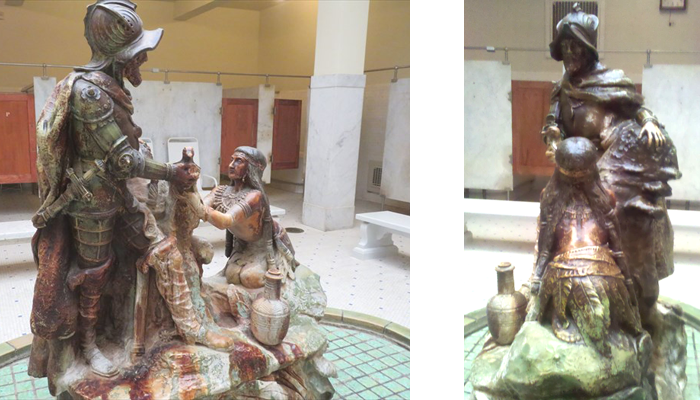
Dr. Jankus: “De Soto’s men searched the hillside all day and into the night, then lay exhausted on the ground. The search went on for three days. The tribes all crept away, but Black Oak stayed behind as a rear guard. De Soto’s men seemed to be digging and turning over rocks wherever water seeped out of the hillside. But nothing was found. Black Oak realized that de Soto was looking for whatever the centurions had left behind, those many years ago. Black Oak, from his tribe’s history, knew exactly where the opening to the cave lay buried. And de Soto did not find it.
“At the end of the third day, de Soto gave up the search. He killed his captured natives. Early on the fourth day his men broke camp and they all moved onward, towards the rising sun. Later, Black Oak learned of de Soto’s death the next year. May of 1542. Killed by his own men, Black Oak was told.
“And just like the earlier legend, a sickness spread across all the tribes of the area that winter. Men, women, and children were all affected. Black Oak recovered, but most of his Caddo tribe died a mysterious and miserable death.
“Black Oak told me that nothing good had ever come from the white men visiting the Caddo people. Nothing good for the Caddo people could possibly be buried in the hillside. Black Oak decided that the knowledge of the cave’s location, having been so carefully passed down across generations, would now be forgotten.
“But, if I really wanted to know, after all this time, Black Oak said he would tell me how to find the cave. Because I had joined the casino’s Gold Circle club.
“I carefully memorized Black Oak’s instructions, handed down person-to-person over the centuries. They were a bit confusing, to say the least. I certainly asked if I could speak with the spirit of any Caddo or pre-Caddo natives who were there when the Romans showed up. But Black Oak said that in order to do that, I would need to spend a whole lot more money in the casino.”
“He did say that,” Dr. Pope chimed in, without elaboration.
Dr. Jankus: “The sun was quickly rising over Chaguate. Black Oak bid me farewell. With the sunrise, the vision faded away. I was on the ground out back of the casino, lying in my own puke. It was 5 a.m. Frank was the only one left. He hosed me off and I laid in the back of the van while he sped towards Hot Springs National Park.”
Dr. Jankus seemed drained after recounting his experience. But after a smoke break and a “B12 injection”, he perked up once more. So there are many more words to this story. Do we have a quota?
Dr. Jankus: “I kept reciting Black Oak’s directions in my head. Not just what he said, but how he said it. We camped out at Gulpha Gorge Campground. Frank and I spent the next three days walking all over Hot Springs Mountain. Up behind the bathhouses.”
Dr. Pope: “We were getting some funny looks from the tourists and the National Park Police. I suggested that Ted wear a shirt.”
Dr. Jankus: “So I was undercover. Black Oak’s directions were a peculiar set of steps and alignment between the hilltops and some of the bigger springs coming out of the hillside. Measurements made in paces between rock outcroppings. Made even more confusing by how the bathhouses have tapped into the springs, and how the road up to the top was cut. Some of the rock outcroppings were clearly no longer visible above ground, but I had a copper ground rod that I could push into the soil to see if there was rock close to the surface.
“After three days of this, and the National Park Police about ready to send us to Leavenworth, we were about ready to give up. We were about out of daylight. We sat on a park bench, dropped some acid, [and] talked about our journey for a while. And then it hit. Something about how the setting sun hit the top of the mountain…”
Dr. Pope jumped up from his seat. “NO! DO NOT TELL HIM!” Dr. Pope then placed a fresh wad of chewing tobacco into his cheek and sat back down.
Dr. Jankus: “Let’s just say an answer appeared. I walked back to the van and got the a shovel and the rock breaker bar. It was getting dark. I took my shirt off and put it in the trash. At the location Black Oak told me about, we had passed over it several times. It hadn’t stood out. But now, with my heightened perception, it seemed obvious. The rod hit rock a few inches below the ground. A minute of digging got us to rock. The rock breaker bar lifted off the one of the rocks on top, and below it was empty blackness. A small opening to a cave within the mountain. A blast of hot, humid air came out.
“I wasn’t going to stop now. It was such a tight fit, and the rocks were hot. I had to strip down nude and lube up with some hand cleaner. Even with Frank pushing, it was still like Winnie the Pooh getting through the window. And I had no pants on. Head first, I slithered in.”
“His friends call him Snake,” Dr. Pope added, helpfully.
Dr. Jankus: “I couldn’t really see. Frank handed me a flashlight, but it was so steamy. I crawled along a few feet, and the passageway opened up into what I would call a small grotto. I could stand up, crouched over. There was a shallow pool of hot water at my feet, so I kept hopping from one foot to the other. It was hard to make out, but there seemed to be another, larger, passageway leading out of the grotto.
“But it was so hot and getting so hard to breathe. Further up and further in, I knew that grotto would lead to something larger. But I could feel my life’s energy sipping away in the heat. For a moment, I thought I had a vision of Black Oak, warning me to turn back. I knew I would die if went on. I was getting lightheaded, short of breath. I focused on the pain. The only thing that’s real.
“I felt my way around, to find the way I came in. I put my hand into the shallow pool to brace myself, and that’s when I touched it. It was like Bilbo Baggins finding the One Ring. I said ‘what’s this?’ when I put my hand on this gold coin. But there was no time to think. I was gasping for air and I needed both hands to escape, so I put that coin in the only place I had for safekeeping.”
Dr. Pope: “His ass.” The awkward silence was broken by Dr. Pope spitting into his cup.
Dr. Jankus: “I crawled back towards that opening. I could feel cooler air and I reached for it. I thought I was done for when I felt a strong hand grab my wrist. Frank here pulled me out through that hole. He saved my life.”
Dr. Pope: “Well, he’d lost a few pounds by the time he came out.”
Dr. Jankus: “Frank dumped me on a park bench while he carefully put the hillside back like we’d found it. He transplanted some vines to really cover things up.”
Dr. Pope: “I really did not want to have to explain any of this to anyone.”
Dr. Jankus: “The park police noticed me, but I looked like any other naked bum sleeping on a park bench, so they left me alone. Frank brought me some water from the drinking fountain nearby, but it was that [expletive] hot water from the springs. I tried to tell Frank the whole story on the drive back here. He did think I had truly lost it this time. But early the next day I had the evidence.”
There, on the card table, Dr. Jankus laid out the nearly-pristine gold coin he had found in the grotto. The Roman aureus, discreetly authenticated and possibly holding incontrovertible proof about the fate of the lost Roman Ninth Legion. A reporter from Radio Free Ozarks declined the opportunity to hold the coin.

Dr. Pope: “Ted here wanted to wear it around his neck. I had to talk him out of drilling a hole in it.”
Dr. Jankus: “We’re still trying to figure out just how much gold might be buried. It seems from Black Oak’s narrative that only a portion of the Ninth Legion was there in Arkansas. Maybe several hundred, with no horses, where a full legion had more than 5000 men, some of them cavalry. But they seemed to be carrying the chests with the payments for all the soldiers. Maybe it was just too heavy to bring with them, so they hid it and planned to return for it later? They had no place to spend it. But if I go with a lowball number of, say, 10,000 aurei, that would be worth more than $3 million today. And that’s based just on the spot price of gold. So would a well-funded museum pay more for such an historical artifact?” Here Dr. Jankus made a rising whistling sound and pointed at the ceiling.
So, uh, how exactly did a Roman legion disappear from Britain, only for part of it to wind up in Hot Springs?
Dr. Jankus: “Well, that is a problem that requires more scholarship. The legion wasn’t near any coast, exactly, and they were not trained in the ways of shipbuilding nor sailing the oceans. Maybe their means of travel killed most of them on the outbound journey, and killed the rest of them on the return. But we’re planning to sit down with maps and some mushrooms and conduct some more ‘alternative research’. We’ll binge-watch Outlander to see if that gives us any ideas.
Dr. Pope: “I remember a talk about North Carolina, and a strange, strange pond.”
Dr. Jankus: “But before we make any public case, I am going back into that damn cave. I will keep myself. I will find a way. Just as soon as we have the funds. We had grand visions about calling the companies that make the space suits for NASA, but [expletive], we’re doing well just to keep gas in the van. So current thinking is we get some scuba gear for breathing and I wear a bunch of those gel ice packs from Walgreens, to offset the heat. There’s a discount if we order a whole box. Those things, and a few good bumps of blow, should give me at least a few minutes to explore.”
Dr. Pope: “We really need the dough, and that’s why I suggested to Ted that we contact Radio Free Ozarks. A news site that very few people actually read, but those 8-10 regular readers are of the highest scientific integrity and are very well off financially. And I’m sure they’re all-around great people. Intellectual visionaries, critical thinkers, and first-rate autodidacts, who I know would keep our story closely held. And who certainly have significant assets in crypto.”
So can you, dear reader who has enriched yourself and your world by reading to the end of this very long article, help fund the Arkansas Archaeological Posse’s return expedition to the cave inside Hot Springs Mountain? For the next 12 months, 80% of all donations of Bitcoin or Monero made to the addresses listed under this web site’s About Us page will go to help fund this critically important archaeological expedition. The AAP, Radio Free Ozarks, and, indeed, the whole of humanity’s scientific, archaeological, and historical knowledge thank you for your time and support!
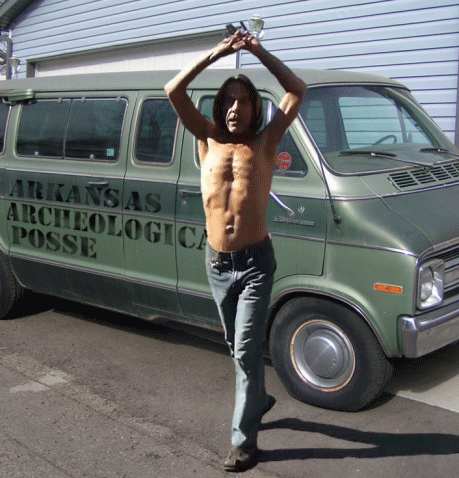
Photo Attributions:
Pottery Shard – Wessex Archaeology (Modified by RFO) CC BY-NC 2
Dodge Van – AutoPhoto (Modified by RFO) CC BY 3.0
Coin – International Numismatic Club – CC BY-SA 4.0
